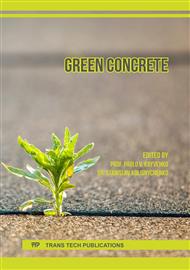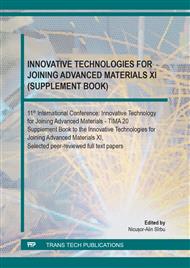[1]
R. Ambrus, M. Izvercian, L. Ivascu, A. Artene, Life cycle sustainability assessment of products in the context of competitiveness, Procedia-Social and Behavioral Sciences 238 (2018) 452-459.
DOI: 10.1016/j.sbspro.2018.04.023
Google Scholar
[2]
Information on http://www.mmediu.ro/beta/wp-content/uploads/2013/04/2013-04-22-CC-RM-deseuri.pdf.
Google Scholar
[3]
H. L. Muttashar, N. B. Ali, M. A. M. Ariffin, M. W Hussin, Microstructures and physical properties of waste garnets as a promising construction material, Case studies in construction materials 8, (2018) 87-96.
DOI: 10.1016/j.cscm.2017.12.001
Google Scholar
[4]
H. L. Muttashar, M. A. M. Ariffin, M. N. Hussein, M. W. Hussin, and S. B Ishaq, Self-compacting geopolymer concrete with spend garnet as sand replacement, Journal of Building Engineering 15 (2018) 85-94.
DOI: 10.1016/j.jobe.2017.10.007
Google Scholar
[5]
H. L. Muttashar, M. A Mohd Ariffin, M. W Hussin, S. B. Ishaq, Realisation of enhanced self-compacting geopolymer concrete using spent garnet as sand replacement, Magazine of Concrete Research 70(11) (2018) 558-569.
DOI: 10.1680/jmacr.17.00212
Google Scholar
[6]
D. Ionescu, S. I. Serbanescu, I. A. Perianu, Patent No. 1. 129363 of 2014, Procedure for obtaining a mortar-type construction material from abrasive material waste, Oficiul de Stat pentru Mărci și Invenții, București, România BOPI 12 (2016).
Google Scholar
[7]
Information on https://jetstar.company/garnet/?v=f5b15f58caba.
Google Scholar
[8]
Information on https://www.sandatlas.org/garnet-sand/.
Google Scholar
[9]
Information on https://gritsablare.ro/en/red-garnet-water-jet-cutting.html/.
Google Scholar
[10]
Information on https://www.gmagarnet.com/en-gb/our-responsibility/garnet-recovery-recycling.
Google Scholar
[11]
A.M. Neville, Properties of Concrete, Pearson Education Limited, London, (2011).
Google Scholar
[12]
ASTM C33 / C33M - 18, Standard Specification for Concrete Aggregates, ASTM International, West Conshohocken, PA, 2018, www.astm.org.
Google Scholar
[13]
P.K. Mehta, P.J.M. Monteiro, Concrete: Microstructure, Properties, and Materials, McGraw-Hill Education, (2013).
Google Scholar
[14]
EN 1097-6, Tests for mechanical and physical properties of aggregates. Determination of particle density and water absorption (2013).
Google Scholar
[15]
EFNARC, Specification and Guidelines for Self-compacting Concrete, UK, (2002).
Google Scholar
[16]
X. X Feng, X. L. Xi, J. W. Cai, H. J. Chai, Y. Z. Song, Investigation of drying shrinkage of concrete prepared with iron mine tailings, Key Engineering Materials 477 (2011) 37-41.
DOI: 10.4028/www.scientific.net/kem.477.37
Google Scholar
[17]
EN 1015-10, Methods of test for mortar for masonry - Part 10: Determination of dry bulk density of hardened mortar (1999).
DOI: 10.3403/01905430u
Google Scholar
[18]
EN 1015-11, Methods of test for mortar for masonry - Part 11: Determination of flexural and compressive strength of hardened mortar (2019).
DOI: 10.3403/01905442u
Google Scholar
[19]
C. Baeră, Self-Healing capacity of Advanced Engineered Cementitious Composites, PhD. Thesis, Technical University of Cluj-Napoca, Cluj-Napoca, Romania, (2016).
DOI: 10.56958/jesi.2019.4.2.169
Google Scholar
[20]
C. Baeră, H. Szilagyi, A. Lăzărescu, Developing Fibre Engineered Cementitious Materials with Self-Healing abilities (SH-FECM) by using polyvinyl alcohol fibres and supplementary powder addition, Proceedings of the fib Symposium (2019) 387-294.
DOI: 10.1051/matecconf/201928901001
Google Scholar
[21]
C. Baeră, H. Szilagyi, C. Matei, A. Hegyi, A. Lăzărescu, A. C. Mircea, Optimizing approach on Fibre Engineered Cementitious Materials with Self-Healing capacity (SH-FECM) by the use of slurry lime (SL) addition, MATEC Web of Conferences 289 (2019), 01001. EDP Sciences.
DOI: 10.1051/matecconf/201928901001
Google Scholar
[22]
A. Lăzărescu, C. Baeră, H. Szilagyi, A Review on the Development of Fly Ash-Based Geopolymer Materials Using Romanian Local Raw Materials, Proceedings of the EUROCOALASH, (2019) 145-156.
DOI: 10.3390/proceedings2020063011
Google Scholar



